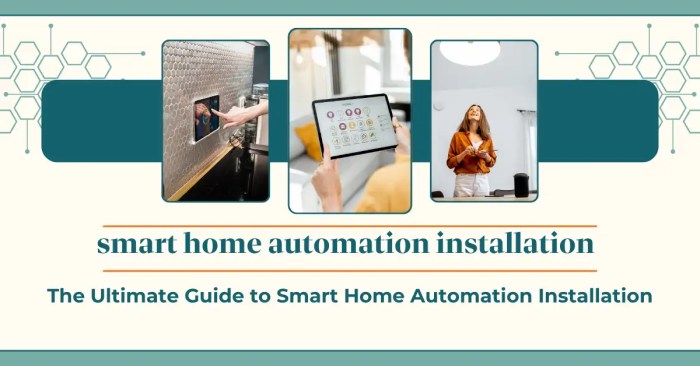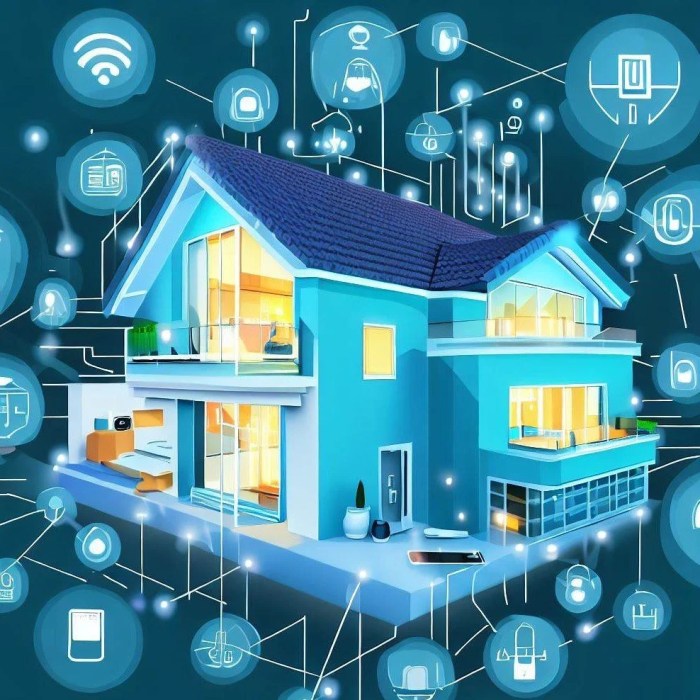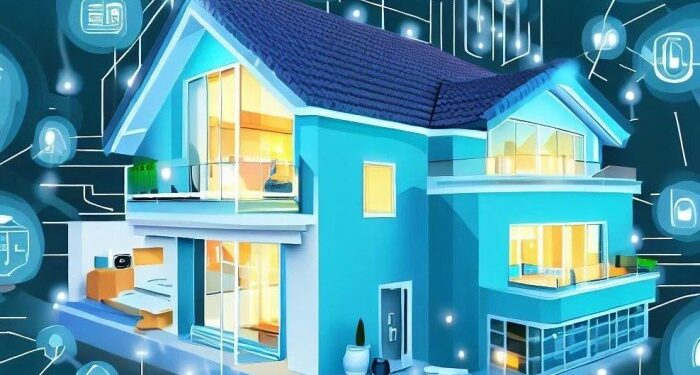The Ultimate Guide to Smart Home Automation and Security delves into the intricacies of modern home technology, shedding light on how automation and security go hand in hand to create a seamless living experience. With a focus on innovation and practicality, this guide aims to equip readers with the knowledge needed to navigate the world of smart homes with ease and confidence.
As we embark on this journey, we will explore various aspects of smart home automation and security, uncovering the benefits, challenges, and future trends that shape this rapidly evolving landscape.
Introduction to Smart Home Automation
Smart home automation refers to the use of technology to control various devices and systems within a home remotely. This technology allows homeowners to manage and monitor their home environment efficiently and conveniently.
Benefits of Automating Home Devices
- Increased convenience: Smart home automation allows for the remote control of devices such as thermostats, lights, and security systems, making it easier for homeowners to manage their homes.
- Enhanced energy efficiency: By automating devices like thermostats and lighting, homeowners can optimize energy usage and reduce their utility bills.
- Improved security: Smart home security systems provide real-time monitoring and alerts, enhancing the overall safety of the home.
Popular Smart Home Devices and Systems
- Smart thermostats: Devices like Nest and Ecobee allow homeowners to control their home's temperature remotely and optimize energy usage.
- Smart lighting: Systems such as Philips Hue enable users to adjust lighting settings and create custom schedules through their smartphones.
- Smart security cameras: Brands like Ring and Arlo offer high-quality cameras with motion detection and two-way audio for enhanced home security.
- Voice assistants: Devices like Amazon Echo and Google Home provide voice control for various smart home devices, offering a convenient hands-free experience.
Smart Home Security Systems
In the realm of smart home automation, security systems play a crucial role in ensuring the safety and protection of your home and loved ones. With the advancement of technology, smart security systems have become more sophisticated, offering a wide range of features to keep your home secure.
Types of Smart Home Security Systems
- Video Doorbells: These devices allow you to see and communicate with visitors at your doorstep, even when you're not home. Some models also offer motion detection and night vision capabilities.
- Smart Cameras: These cameras can be placed indoors or outdoors to monitor your home in real-time. They often come with features like two-way audio, facial recognition, and cloud storage.
- Smart Locks: With smart locks, you can control access to your home remotely. You can lock or unlock your doors using a smartphone app and even provide temporary access codes to guests.
- Motion Sensors: Motion sensors can detect movement in and around your home, triggering alerts to your smartphone. They are useful for detecting intruders or monitoring activity in specific areas.
Tips for Choosing the Right Security System
- Assess Your Needs: Consider the size of your home, the level of security you require, and any specific features you want in a security system.
- Compatibility: Ensure that the security system you choose is compatible with other smart devices in your home, such as smart lights or thermostats.
- Professional Monitoring: Decide whether you want a security system with professional monitoring services or if you prefer a self-monitored system.
- Installation: Choose a security system that is easy to install and set up, whether you opt for a DIY installation or professional installation.
Integration of Smart Devices
Smart home automation involves the seamless integration of various smart devices to create a cohesive ecosystem that enhances convenience, efficiency, and security for homeowners. This integration allows different devices to communicate with each other and work together to automate tasks and routines.
Role of Artificial Intelligence
Artificial intelligence plays a crucial role in the integration of smart devices in a smart home ecosystem. AI-powered systems can analyze data from different devices, learn user preferences, and make intelligent decisions to optimize efficiency and enhance user experience.
- AI algorithms can predict user behavior and adjust settings automatically to meet individual preferences, such as adjusting smart thermostats based on occupancy patterns.
- AI can also enable devices to learn from user interactions and adapt their functionality over time, providing a personalized and tailored smart home experience.
- Integrating AI into smart devices allows for advanced automation capabilities, such as voice control, predictive maintenance, and proactive security measures.
Automation Streamlining Daily Tasks
Automation in a smart home ecosystem can streamline daily tasks and routines, making life more convenient and efficient for homeowners. By connecting different devices and systems, automation can simplify processes and reduce the need for manual intervention.
- For example, integrating smart lighting, smart blinds, and motion sensors can automate lighting adjustments based on natural light levels and occupancy, enhancing energy efficiency and comfort.
- Smart home hubs can act as central control centers, allowing users to manage and automate various devices from a single interface, simplifying operation and enhancing usability.
- Automation can also enhance home security by integrating smart cameras, sensors, and alarms to detect and respond to potential threats automatically, providing peace of mind for homeowners.
Data Privacy and Security Concerns
In the world of smart home automation, data privacy and security are major concerns that need to be addressed to ensure the safety and protection of personal information and property.
Common Privacy and Security Risks
- Unauthorized access to smart devices: Hackers may exploit vulnerabilities in smart home devices to gain access to personal data or control over the devices.
- Data breaches: Inadequately secured smart home systems can lead to data breaches, exposing sensitive information to cybercriminals.
- Privacy invasion: Poorly configured cameras or microphones in smart devices can compromise privacy by unknowingly recording or transmitting sensitive conversations.
Tips for Securing Smart Home Devices and Networks
- Change default passwords: Always change default passwords on smart devices to unique, strong passwords to prevent unauthorized access.
- Update firmware regularly: Keep smart devices up to date with the latest firmware updates to patch security vulnerabilities.
- Enable encryption: Use encryption methods such as WPA2 for Wi-Fi networks to secure data transmissions between devices.
- Implement multi-factor authentication: Add an extra layer of security by enabling multi-factor authentication for smart home device access.
Importance of Keeping Smart Home Systems Updated
Regularly updating smart home systems is crucial in maintaining the security and functionality of the devices. Updates often contain security patches that address vulnerabilities identified by manufacturers or security experts, reducing the risk of cyber attacks and data breaches.
Voice Control and Virtual Assistants

Voice control technology plays a crucial role in enhancing smart home automation by allowing users to control various devices and systems through voice commands. This hands-free approach makes it convenient and efficient for users to manage their smart homes seamlessly.
Popular Virtual Assistants
- Alexa: Developed by Amazon, Alexa is one of the most popular virtual assistants known for its wide range of skills and compatibility with various smart devices. It can perform tasks like setting reminders, playing music, and controlling smart home devices.
- Google Assistant: Google Assistant is another widely used virtual assistant that integrates well with Google products and services. It offers voice-controlled assistance for tasks like scheduling appointments, checking the weather, and controlling smart home devices.
- Siri: Siri is Apple's virtual assistant designed for iOS devices. It provides voice-activated assistance for tasks like sending messages, making calls, and controlling smart home devices compatible with Apple's HomeKit platform.
Tips for Setting Up and Using Virtual Assistants
- Ensure that your smart devices are compatible with the virtual assistant you choose to use.
- Follow the setup instructions provided by the virtual assistant's app to connect and configure your smart home devices.
- Practice using voice commands to control different devices and systems in your smart home for a hands-free experience.
- Explore the skills and features offered by the virtual assistant to maximize its functionality and enhance your smart home automation experience.
Energy Efficiency and Cost Savings
Smart home automation plays a crucial role in promoting energy efficiency and cost savings for homeowners. By integrating various smart devices and systems, individuals can effectively monitor and control their energy usage, leading to reduced utility bills and a more sustainable lifestyle.
Energy-Efficient Smart Devices and Systems
- Smart Thermostats: Devices like Nest and Ecobee learn your schedule and preferences to optimize heating and cooling, reducing energy waste.
- Smart Lighting: LED bulbs and smart switches can be programmed to turn off when not in use or adjust brightness based on natural light, saving electricity.
- Solar Panels: Integrating solar panels with smart inverters can harness renewable energy and potentially eliminate electricity bills in the long run.
Long-Term Cost Benefits of Smart Home Technology
- Reduced Energy Bills: By monitoring and optimizing energy usage, smart home technology can lead to significant savings on monthly utility bills.
- Increased Home Value: Investing in energy-efficient smart devices can increase the resale value of your home, appealing to eco-conscious buyers.
- Remote Monitoring: With remote access to control devices, homeowners can prevent energy wastage and reduce costs even when away from home.
Smart Home Automation for Health and Wellness
Smart home technology is not only about convenience and security but also has the potential to support health and wellness goals. By integrating smart devices into our homes, we can monitor our health metrics, create healthier habits, and improve overall well-being.
Role of Smart Devices in Monitoring Health Metrics
- Smart wearable devices such as fitness trackers and smartwatches can track physical activity, heart rate, sleep patterns, and even stress levels.
- Smart scales can provide insights into weight trends, body composition, and even calculate BMI.
- Smart thermometers can monitor body temperature and detect fever, providing early indications of illness.
Examples of Smart Home Devices for Healthcare Applications
- Smart blood pressure monitors that sync with mobile apps to track and analyze blood pressure readings over time.
- Smart pill dispensers that remind users to take medication and track adherence to treatment plans.
- Smart air purifiers that monitor air quality and filter out allergens and pollutants, promoting respiratory health.
Future Trends in Smart Home Automation
Smart home automation is an ever-evolving field, with constant advancements and innovations shaping the way we interact with our living spaces. As technology continues to progress, there are several key trends that are expected to define the future of smart home automation.
Integration of Artificial Intelligence
Artificial Intelligence (AI) is set to play a significant role in the future of smart home automation. With the integration of AI-powered systems and devices, smart homes will be able to learn and adapt to the preferences and habits of their occupants.
This will result in a more personalized and intuitive user experience, where smart devices anticipate the needs of users and proactively take action to enhance comfort and efficiency.
Enhanced Connectivity through 5G
The rollout of 5G technology is expected to revolutionize the way smart home devices communicate with each other and with the cloud. With faster and more reliable connectivity, smart homes will be able to support a higher number of connected devices, leading to a more seamless and integrated ecosystem.
This will enable more sophisticated automation and control capabilities, as well as improved responsiveness and reliability.
Focus on Sustainability and Energy Efficiency
As environmental concerns continue to grow, there is a greater emphasis on sustainability and energy efficiency in smart home automation. Future trends are expected to prioritize the development of smart devices and systems that not only enhance convenience and comfort but also reduce energy consumption and promote eco-friendly practices.
This includes the integration of renewable energy sources, smart energy management systems, and advanced monitoring tools to help homeowners make more informed decisions about their energy usage.
Expansion of Smart Home Ecosystems
The future of smart home automation will see a significant expansion of interconnected ecosystems, where different devices and platforms work together seamlessly to create a more comprehensive and cohesive smart home experience. This will involve greater integration between smart home devices from different manufacturers, as well as the development of standardized protocols and interfaces to ensure compatibility and interoperability across various products and services.
Enhanced Security and Privacy Measures
With the increasing prevalence of smart home devices and the growing concerns around data privacy and security, future trends in smart home automation will focus on enhancing security measures to protect sensitive information and ensure the privacy of users. This includes the implementation of robust encryption protocols, multi-factor authentication, and secure data storage practices to prevent unauthorized access and safeguard personal data from cyber threats.
Ending Remarks

In conclusion, The Ultimate Guide to Smart Home Automation and Security serves as a roadmap for those looking to transform their living spaces into intelligent, secure environments. By embracing the latest technologies and best practices, homeowners can enhance their quality of life while staying ahead of the curve in the digital age.
FAQ Corner
How secure are smart home devices?
Smart home devices can be vulnerable to cyber attacks if not properly secured. It's crucial to regularly update firmware, use strong passwords, and secure your home network to minimize risks.
Can smart home devices communicate with each other?
Yes, smart devices can communicate with each other through protocols like Zigbee, Z-Wave, or Wi-Fi. This allows for seamless integration and automation within a smart home ecosystem.
What are the energy-saving benefits of smart home automation?
Smart home automation can lead to energy savings by optimizing usage patterns, adjusting settings based on occupancy, and monitoring energy consumption in real time. This can result in lower utility bills and reduced environmental impact.



